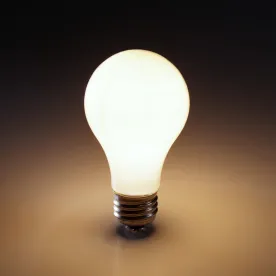On September 5, 2019, the U.S. Department of Energy (DOE) published a final rule and proposed rule regarding general service lamps and general service incandescent lamps with far-reaching implications for lamp manufacturers and retailers. DOE is withdrawing the Obama Administration’s revised definitions of general service lamps and general service incandescent lamps, which would have imposed federal efficiency standards on a wide array of lamps. DOE also asserts in the new rule that it has not triggered a statutory “backstop” efficiency standard, which would have prohibited the sale of all non-compliant lamps beginning January 1, 2020. In a separate proposed rule, DOE has initially determined that energy conservation standards for general service incandescent lamps are not justified. DOE’s decisions, which stall what was to be an accelerated transition away from incandescents and toward LEDs, will likely prompt a legal challenge by consumer and environmental groups, as well as a number of states and other interested stakeholders.
Background
As defined by Congress in the Energy Policy and Conservation Act of 1975 (EPCA), general service incandescent lamps (GSILs) are any “standard incandescent or halogen type lamp . . . intended for general service applications,” that “has a medium screw base,” that fits within statutorily defined lumen and operating voltage ranges, and that is not one of twenty-two exempted lamp types. General service lamps (GSLs), in turn, are GSILs or “any other lamps that the Secretary [of Energy] determines are used to satisfy lighting applications traditionally served by general service incandescent lamps.” With the Energy Independence and Security Act of 2007 (EISA), Congress directed DOE to initiate rulemaking procedures to determine whether efficiency standards for GSLs should be amended to be “more stringent” than those that currently apply to fluorescent lamps and incandescent reflector lamps and whether existing exemptions for “certain incandescent lamps should be maintained or discontinued.”
The EISA sought to prod DOE into moving quickly to establish GSL/GSIL efficiency standards. First, Congress provided that if DOE “determines that the standards in effect for general service incandescent lamps should be amended, the Secretary shall publish a final rule not later than” January 1, 2017. Second, Congress included a “backstop” measure: if the Secretary of Energy “fails to complete a rulemaking” as directed, “the Secretary shall prohibit the sale of any general service lamp that does not meet a minimum efficacy standard of 45 lumens per watt,” effective January 1, 2020. The 45-lumen standard is generally understood to be unachievable for many incandescents, and would, therefore, hasten an ongoing transition to LED lamps. The backstop standard is also unusual to the extent that it would apply as a prohibition on sale, while most other appliance and equipment standards enforced by DOE apply to import and manufacture, rather than sale. As a result, the backstop not only impacts lamp manufacturers, but also the retailers who market such lamps.
The Obama Administration in January 2017 promulgated final rules revising the GSL and GSIL definitions to no longer exempt five categories of specialty incandescent lamps (rough service lamps, shatter-resistant lamps, 3-way incandescent lamps, high lumen incandescent lamps, and vibration service lamps), incandescent reflector lamps, or a variety of decorative lamps (T-Shape, B, BA, CA, F, G16-1/2, G25, G30, S, M-14, and candelabra base lamps). Effective January 1, 2020, these lamp categories would be subject to the relevant efficiency standards. The Obama Administration, however, did not initiate rulemaking with regard to the efficiency standards themselves because an appropriations rider prevented it from doing so.
The Trump Administration’s recent move withdraws these revised definitions to maintain the current efficiency regulatory scheme. Without deciding whether or not to amend the efficiency standards themselves, DOE’s new rule prevents those standards from applying to the specialty, decorative, and reflector lamps identified under the earlier rule. Some commenters argue that the new rule violates the EPCA’s “anti-backsliding” provision, while DOE asserts that the provision applies only to efficiency standards and not to the categories to which those standards apply.
Regulatory Uncertainty Regarding “Backstop” Standards
With the new rule, DOE concludes that the backstop will not take effect on January 1 and so will not prohibit the sale of GSLs not meeting the 45 lumens per watt standard. DOE agreed with electrical and lighting trade associations and manufacturers that the backstop would only be triggered if DOE had actually determined to maintain, amend, or eliminate GSL and GSIL efficiency standards but failed to do so, whereas to date, DOE had determined only to maintain the currently effective list of exemptions from the GSL and GSIL definitions. Additionally, DOE states that the backstop is not self-executing but rather requires the Secretary to take action to prohibit the sale of less efficient lamps. DOE asserts that this interpretation of the backstop provision prevents the Secretary of Energy from having to enforce a more stringent efficiency standard that he has not yet determined to be necessary or unnecessary.
A variety of environmental commenters, utility companies, and state attorneys general disagree with DOE’s reading and argue that, without further action, the backstop provision will indeed be triggered on January 1, 2020, because DOE has “fail[ed] to complete” the congressionally directed rulemaking to determine the need for amended efficiency standards. These commenters argue that the backstop is self-executing and requires no further DOE action to go into effect.
Preemption
In recent years, states have begun to enact their own lamp efficiency standards in line with the Obama Administration’s proposal and Congress’ “backstop” standard, in part out of concern that DOE might seek to delay or reverse the federal standard. More states are likely to do so in light of DOE’s latest move, creating the possibility that lamp manufacturers, importers, and retailers will have to navigate a patchwork of state regulations. Such state regulations will likely be subject to litigation, as DOE asserts that even though it has not yet promulgated an efficiency standard, state standards for covered products are preempted.
Next Steps
DOE’s withdrawal of the revised GSL/GSIL definitions or its interpretation of the backstop provision has not yet prompted a legal challenge. Some environmental advocates, however, have raised the possibility of bringing suit to force implementation of the lamp efficiency standards.
Co-author: Jack Zietman




 />i
/>i

